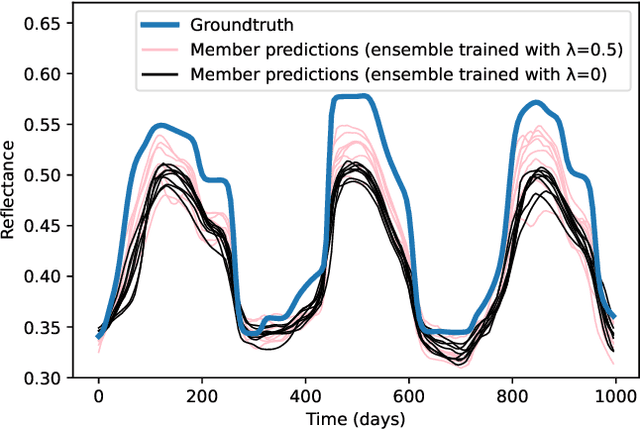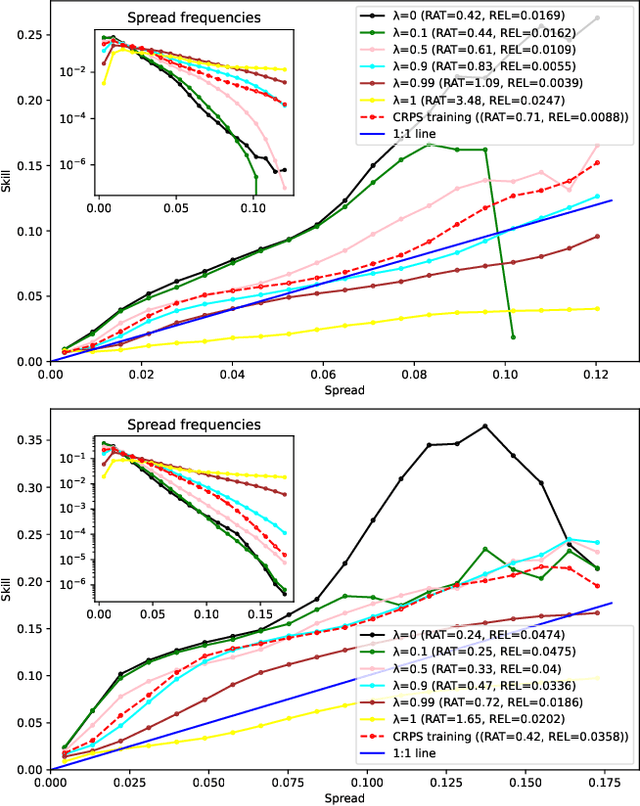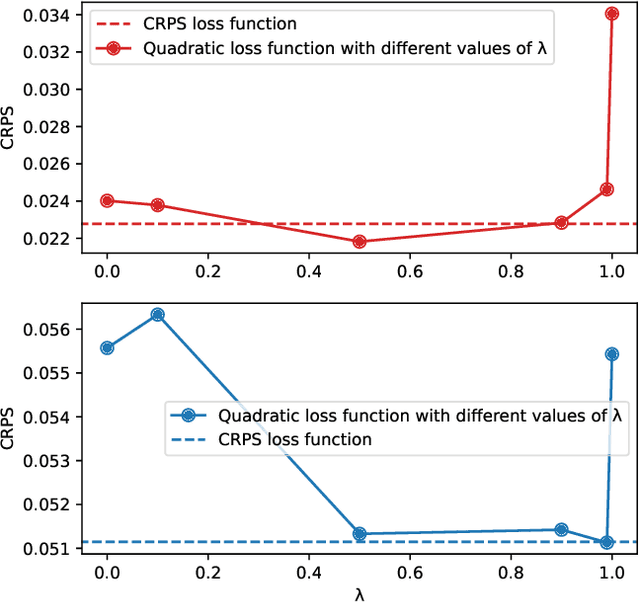Lucas Drumetz
IMT Atlantique - MEE, Lab-STICC_OSE
Busemann Functions in the Wasserstein Space: Existence, Closed-Forms, and Applications to Slicing
Oct 06, 2025Abstract:The Busemann function has recently found much interest in a variety of geometric machine learning problems, as it naturally defines projections onto geodesic rays of Riemannian manifolds and generalizes the notion of hyperplanes. As several sources of data can be conveniently modeled as probability distributions, it is natural to study this function in the Wasserstein space, which carries a rich formal Riemannian structure induced by Optimal Transport metrics. In this work, we investigate the existence and computation of Busemann functions in Wasserstein space, which admits geodesic rays. We establish closed-form expressions in two important cases: one-dimensional distributions and Gaussian measures. These results enable explicit projection schemes for probability distributions on $\mathbb{R}$, which in turn allow us to define novel Sliced-Wasserstein distances over Gaussian mixtures and labeled datasets. We demonstrate the efficiency of those original schemes on synthetic datasets as well as transfer learning problems.
Object-Centric Cropping for Visual Few-Shot Classification
Jul 31, 2025Abstract:In the domain of Few-Shot Image Classification, operating with as little as one example per class, the presence of image ambiguities stemming from multiple objects or complex backgrounds can significantly deteriorate performance. Our research demonstrates that incorporating additional information about the local positioning of an object within its image markedly enhances classification across established benchmarks. More importantly, we show that a significant fraction of the improvement can be achieved through the use of the Segment Anything Model, requiring only a pixel of the object of interest to be pointed out, or by employing fully unsupervised foreground object extraction methods.
Anomalous Samples for Few-Shot Anomaly Detection
Jul 31, 2025Abstract:Several anomaly detection and classification methods rely on large amounts of non-anomalous or "normal" samples under the assump- tion that anomalous data is typically harder to acquire. This hypothesis becomes questionable in Few-Shot settings, where as little as one anno- tated sample can make a significant difference. In this paper, we tackle the question of utilizing anomalous samples in training a model for bi- nary anomaly classification. We propose a methodology that incorporates anomalous samples in a multi-score anomaly detection score leveraging recent Zero-Shot and memory-based techniques. We compare the utility of anomalous samples to that of regular samples and study the benefits and limitations of each. In addition, we propose an augmentation-based validation technique to optimize the aggregation of the different anomaly scores and demonstrate its effectiveness on popular industrial anomaly detection datasets.
Augmented Invertible Koopman Autoencoder for long-term time series forecasting
Mar 17, 2025Abstract:Following the introduction of Dynamic Mode Decomposition and its numerous extensions, many neural autoencoder-based implementations of the Koopman operator have recently been proposed. This class of methods appears to be of interest for modeling dynamical systems, either through direct long-term prediction of the evolution of the state or as a powerful embedding for downstream methods. In particular, a recent line of work has developed invertible Koopman autoencoders (IKAEs), which provide an exact reconstruction of the input state thanks to their analytically invertible encoder, based on coupling layer normalizing flow models. We identify that the conservation of the dimension imposed by the normalizing flows is a limitation for the IKAE models, and thus we propose to augment the latent state with a second, non-invertible encoder network. This results in our new model: the Augmented Invertible Koopman AutoEncoder (AIKAE). We demonstrate the relevance of the AIKAE through a series of long-term time series forecasting experiments, on satellite image time series as well as on a benchmark involving predictions based on a large lookback window of observations.
FlowKac: An Efficient Neural Fokker-Planck solver using Temporal Normalizing flows and the Feynman Kac-Formula
Mar 14, 2025Abstract:Solving the Fokker-Planck equation for high-dimensional complex dynamical systems remains a pivotal yet challenging task due to the intractability of analytical solutions and the limitations of traditional numerical methods. In this work, we present FlowKac, a novel approach that reformulates the Fokker-Planck equation using the Feynman-Kac formula, allowing to query the solution at a given point via the expected values of stochastic paths. A key innovation of FlowKac lies in its adaptive stochastic sampling scheme which significantly reduces the computational complexity while maintaining high accuracy. This sampling technique, coupled with a time-indexed normalizing flow, designed for capturing time-evolving probability densities, enables robust sampling of collocation points, resulting in a flexible and mesh-free solver. This formulation mitigates the curse of dimensionality and enhances computational efficiency and accuracy, which is particularly crucial for applications that inherently require dimensions beyond the conventional three. We validate the robustness and scalability of our method through various experiments on a range of stochastic differential equations, demonstrating significant improvements over existing techniques.
Land Surface Temperature Super-Resolution with a Scale-Invariance-Free Neural Approach: Application to MODIS
Feb 03, 2025



Abstract:Due to the trade-off between the temporal and spatial resolution of thermal spaceborne sensors, super-resolution methods have been developed to provide fine-scale Land SurfaceTemperature (LST) maps. Most of them are trained at low resolution but applied at fine resolution, and so they require a scale-invariance hypothesis that is not always adapted. Themain contribution of this work is the introduction of a Scale-Invariance-Free approach for training Neural Network (NN) models, and the implementation of two NN models, calledScale-Invariance-Free Convolutional Neural Network for Super-Resolution (SIF-CNN-SR) for the super-resolution of MODIS LST products. The Scale-Invariance-Free approach consists ontraining the models in order to provide LST maps at high spatial resolution that recover the initial LST when they are degraded at low resolution and that contain fine-scale texturesinformed by the high resolution NDVI. The second contribution of this work is the release of a test database with ASTER LST images concomitant with MODIS ones that can be usedfor evaluation of super-resolution algorithms. We compare the two proposed models, SIF-CNN-SR1 and SIF-CNN-SR2, with four state-of-the-art methods, Bicubic, DMS, ATPRK, Tsharp,and a CNN sharing the same architecture as SIF-CNN-SR but trained under the scale-invariance hypothesis. We show that SIF-CNN-SR1 outperforms the state-of-the-art methods and the other two CNN models as evaluated with LPIPS and Fourier space metrics focusing on the analysis of textures. These results and the available ASTER-MODIS database for evaluation are promising for future studies on super-resolution of LST.
Koopman Ensembles for Probabilistic Time Series Forecasting
Mar 13, 2024


Abstract:In the context of an increasing popularity of data-driven models to represent dynamical systems, many machine learning-based implementations of the Koopman operator have recently been proposed. However, the vast majority of those works are limited to deterministic predictions, while the knowledge of uncertainty is critical in fields like meteorology and climatology. In this work, we investigate the training of ensembles of models to produce stochastic outputs. We show through experiments on real remote sensing image time series that ensembles of independently trained models are highly overconfident and that using a training criterion that explicitly encourages the members to produce predictions with high inter-model variances greatly improves the uncertainty quantification of the ensembles.
Sliced-Wasserstein Distances and Flows on Cartan-Hadamard Manifolds
Mar 11, 2024



Abstract:While many Machine Learning methods were developed or transposed on Riemannian manifolds to tackle data with known non Euclidean geometry, Optimal Transport (OT) methods on such spaces have not received much attention. The main OT tool on these spaces is the Wasserstein distance which suffers from a heavy computational burden. On Euclidean spaces, a popular alternative is the Sliced-Wasserstein distance, which leverages a closed-form solution of the Wasserstein distance in one dimension, but which is not readily available on manifolds. In this work, we derive general constructions of Sliced-Wasserstein distances on Cartan-Hadamard manifolds, Riemannian manifolds with non-positive curvature, which include among others Hyperbolic spaces or the space of Symmetric Positive Definite matrices. Then, we propose different applications. Additionally, we derive non-parametric schemes to minimize these new distances by approximating their Wasserstein gradient flows.
On Transfer in Classification: How Well do Subsets of Classes Generalize?
Mar 06, 2024Abstract:In classification, it is usual to observe that models trained on a given set of classes can generalize to previously unseen ones, suggesting the ability to learn beyond the initial task. This ability is often leveraged in the context of transfer learning where a pretrained model can be used to process new classes, with or without fine tuning. Surprisingly, there are a few papers looking at the theoretical roots beyond this phenomenon. In this work, we are interested in laying the foundations of such a theoretical framework for transferability between sets of classes. Namely, we establish a partially ordered set of subsets of classes. This tool allows to represent which subset of classes can generalize to others. In a more practical setting, we explore the ability of our framework to predict which subset of classes can lead to the best performance when testing on all of them. We also explore few-shot learning, where transfer is the golden standard. Our work contributes to better understanding of transfer mechanics and model generalization.
Physics Informed and Data Driven Simulation of Underwater Images via Residual Learning
Feb 07, 2024Abstract:In general, underwater images suffer from color distortion and low contrast, because light is attenuated and backscattered as it propagates through water (differently depending on wavelength and on the properties of the water body). An existing simple degradation model (similar to atmospheric image "hazing" effects), though helpful, is not sufficient to properly represent the underwater image degradation because there are unaccounted for and non-measurable factors e.g. scattering of light due to turbidity of water, reflective characteristics of turbid medium etc. We propose a deep learning-based architecture to automatically simulate the underwater effects where only a dehazing-like image formation equation is known to the network, and the additional degradation due to the other unknown factors if inferred in a data-driven way. We only use RGB images (because in real-time scenario depth image is not available) to estimate the depth image. For testing, we have proposed (due to the lack of real underwater image datasets) a complex image formation model/equation to manually generate images that resemble real underwater images (used as ground truth). However, only the classical image formation equation (the one used for image dehazing) is informed to the network. This mimics the fact that in a real scenario, the physics are never completely known and only simplified models are known. Thanks to the ground truth, generated by a complex image formation equation, we could successfully perform a qualitative and quantitative evaluation of proposed technique, compared to other purely data driven approaches
 Add to Chrome
Add to Chrome Add to Firefox
Add to Firefox Add to Edge
Add to Edge